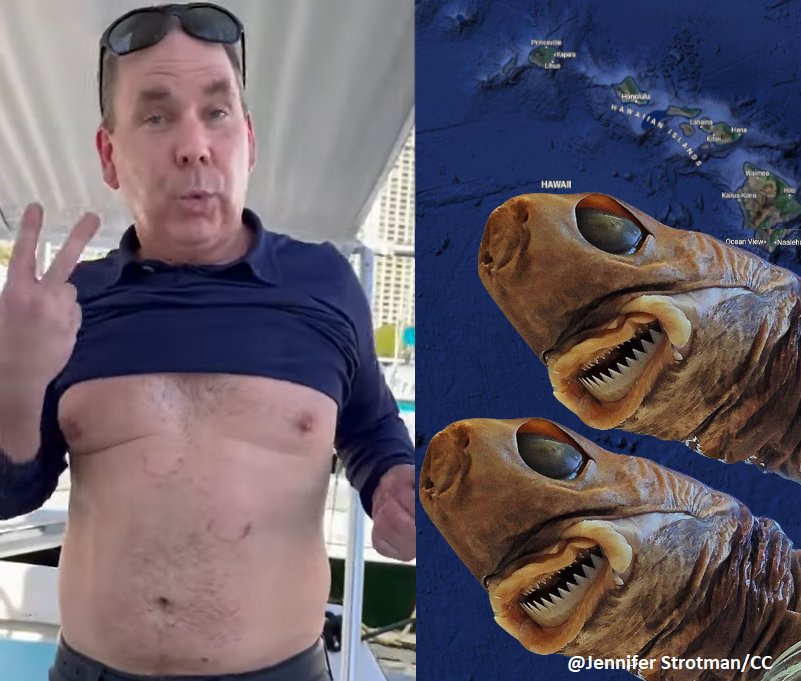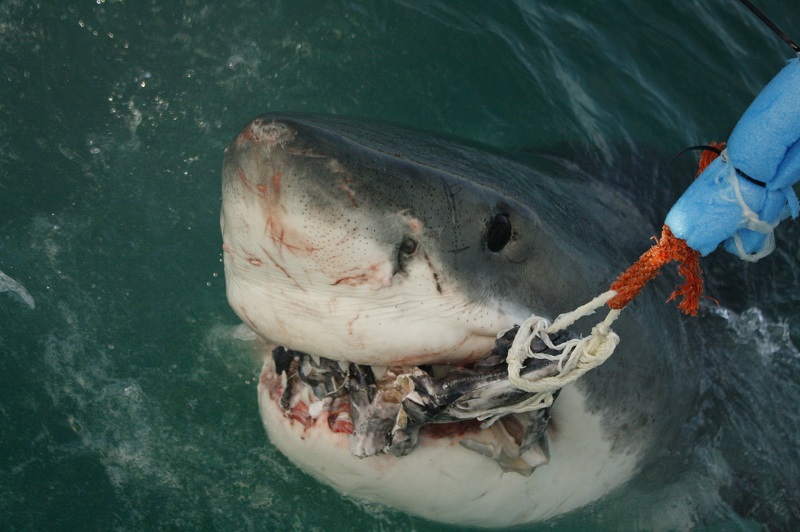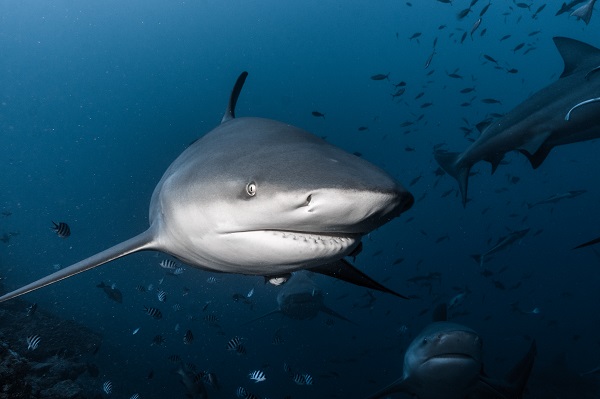A deep-water swimmer averted serious injury when he forcibly grabbed and threw two attacking cookiecutter sharks.
Andy Walberer, 50, had smeared himself with diaper cream before he started his Molokai channel swim March 19 at 5:58 p.m.
The experienced swimmer was followed by a support kayak sporting two shark deterrent devices both with 4- to 6-foot cables attached.
His swim was going well until he was approximately 12 miles off the coast. Around 11:55 p.m. Walberer was 200 to 300 yards behind his support boat and 5 to 6 feet from the support kayak when he felt something hit his chest.
“I was 95% sure it was a cookiecutter when I was bit,” he told Tracking Sharks.
“I felt its narrow, slimy, wrinkly body in my right hand as soon as I closed my hand around it.”
Walberer had consulted a medical journal in preparation for the swim and read about other cookiecutter shark bites in the area and knew exactly what he was holding.
He grasped the shark, which he estimated was about 1.5 inches round, and threw it as far as he could and, amazingly, he kept on swimming. A few seconds later he was hit a second time and initially thought he hadn’t thrown the shark far enough away, but he repeated the motion on the second shark and threw it as hard he could. He later learned cookiecutter sharks tend to hunt in pairs, and this was the second shark.

“I was pretty freaked out in that moment. It was near midnight on a moonless night. I was 12 to 15 miles from both Molokai and Oahu and the kayak near me was only lit with 4 or 5 red glow sticks, so I could not see much,” he said.
After 30 or so seconds, he was able to regain his composure, touched his stomach and, not feeling any major damage, he continued swimming.
Once he stopped, treading water and intaking some calories, he had his support crew shine a light to look for any damage. He continued swimming for 6 1/2 hours but tried to stay close to the kayak and its protective shark shields, which gave him a little comfort.
He credits his crew for staying calm throughout the ordeal which helped him stay calm and focus on swimming.
Cookiecutter sharks use suction to suck in flesh and then quickly spin to remove a large circle of flesh from their victims. Walberer wondered if the diaper cream he coated on his body before the swim prevented the shark’s mouth from making a good seal on his chest.
He advises other open ocean swimmers to quickly grab any fish that bumps into them. If it is a cookiecutter shark, they may be able to throw it away before it causes serious damage. Walberer shared his story so others may learn from his encounter.
Cookiecutter sharks are smaller sharks that reach around 42 to 56 cm or 16.5-22 inches in length.
They have gnarly teeth on their bottom jaws and when attacking prey will suck the victim, grabbing a chunk of flesh in their mouths before doing a quick 180 turn to pull out a plug of muscle or flesh. The unfortunate prey will be left with a gouge that looks like someone took a cookiecutter form and pulled out a plug of flesh.
Cookiecutters are experts in camouflage and have the highest luminescence of any known shark. The photophores (light-producing organs) help break up their silhouette to keep it hidden from sharp-eyed predators. In addition, the flashing may help the shark to blend in with squid. The shark can hide among soft-bodied mollusks and attack larger predators as they feed on the squid.
Cookiecutter sharks have been known to strike submarines, undersea cables and, unfortunately, the occasional swimmer. The good news for ocean lovers is the sharks are nocturnal and are usually only found in deeper waters.
Other cookiecutter shark attacks bites
In 1992, a fisherman’s body was discovered floating 15 miles off the coast of Waianae, marking the first recorded instance of a human being bitten by a cookiecutter shark. The victim had secured himself to an ice chest, but the medical examiner determined that the bites had occurred postmortem.
The first confirmed cookiecutter shark bite on a living human occurred March 16, 2009. Mike Spalding, 61, was ten miles off the coast and less than five hours into his swim when he was bitten while swimming across the Alenuhihaha Channel.
Around 8 p.m. in the pitch-black night, he felt a prick on his chest and knew he needed to get out of the water. He swam to his support kayak and, as he was climbing onboard, was bitten on the left calf. The tiny shark left a 3-inch round 1-inch-deep hole in Spalding’s left calf and a superficial bite on the chest.
Sitting on the kayak, which was filling with blood, he alerted his support boat and was collected before being taken ashore and then driven to the hospital by his wife.
Jack Tolley, 7, was swimming with family members in in Alma Bay off north Queensland, Australia when he had he was bitten in 2017.
Jack was in the water with his dad when the little fish showed up. His dad commented that it was a friendly little fish before it smashed into his leg and bit Jack’s outer right calf. Jack’s father kicked the fish as his mother rushed into the water to collect her son.
Jack was treated by paramedics before being taken to the hospital where he spent 3 days. Thankfully, the nearly 3-inch wound did not require a skin graft.
Two other people were nipped by a tiny shark in the same area. The wounds were apparently superficial but may have been caused by the same shark.
In this case, the shark was spotted during the day which indicates it may have been sick or dying as it swam in the shallows during the daylight.
In 2019 three people were bitten by cookiecutter sharks swimming in the Kaiwi Channel.
Erich Schall, 58, and his friend Steve Gruenwald flew to Hawaii and began their 26-mile swim March 18.
After months of planning, Isaiah Mojica, 23, entered the water for his channel swim April 5, 2019. His swim ended when a cookiecutter shark left a 3-inch hole in his shoulder.
A third cookiecutter struck July 29. Adherbal Treidler de Oliveira, 49, started his Molokai Channel swim at 4:23 p.m. Six hours later he was missing a 3-inch plug of flesh from his leg.
An unnamed person was bitten on the right foot and calf Feb. 9, 2022, off Kailua-Kona. The person was 1.5 miles from shore, but no other information was made available.
The sharks tend to be active in the deepwater late at night. Walbere is the only known swimmer to have stopped a cookiecutter from causing severe injury.
Channel swimmers may want to seriously consider Walberer’s diaper cream use and duplicating his technique.
The location has been marked on the 2023 Shark Attack Map.


